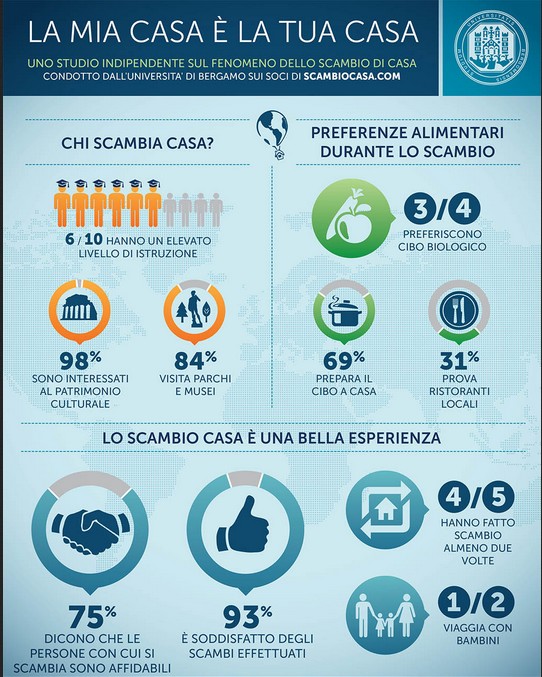“Il primo scambio è sempre un’emozione speciale e anche una preoccupazione grande per i mille dettagli da curare. Il nostro primo scambio è stato con una famiglia di Siena e di sicuro sarà indimenticabile. E’ la prima volta che vivi la città non da turista ma da visitante, la prima volta che invece di stare in una piccola camera d’albergo ti trovi in una casa ampia con personalità e tante possibilità, la prima volta che fai la spesa e cucini qualcosa nella tua nuova cucina e la prima volta che accetti e dai consigli e suggerimenti preziosi sul nuovo posto; questa prima volta non la puoi scordare.”
Così Alicia Jimenez, originaria della Spagna e residente a Torino, racconta il suo primo scambio effettuato grazie a Scambiocasa.com, il più ampio circuito nello scambio di casa e di ospitalità nel mondo.
Quando Ed Kushins fondò l’organizzazione (in inglese HomeExchange.com) nel 1992 in California, era convinto che lo scambio di casa fosse l’alternativa ideale alle formule classiche di soggiorno quali case in affitto, alberghi o villaggi turistici poiché tale formula permette, a costi ridotti, di viaggiare, da solo, in coppia, in famiglia o tra amici, al di fuori dei sentieri battuti dal turismo di massa.
Tutto quello che bisogna fare è iscriversi al portale e mettere a disposizione la propria abitazione iniziando a progettare la propria vacanza.
E così ha fatto Alicia qualche anno fa, diventando uno dei più di 63.000 soci di HomeExchange.com in 154 paesi del mondo.
“Dopo il primo scambio c’è stato di tutto” racconta “scambi in Italia, paese meraviglioso ma un po’ caro per il turista, in Europa (Francia, Inghilterra, Irlanda, Danimarca, Olanda, Repubblica Ceca) e perfino in America (tre mesi in Canada in quattro case diverse più una settimana a Chicago). Scambi simultanei per la maggior parte perché questa è la nostra casa ma anche non simultanei (in questo momento ci devono uno in Grecia e un altro a Seattle e non vediamo l’ora di andarci). Brevi o lunghi. Con prime o seconde case. Ci sono state case piccole, grandi, vecchie, nuove, con il giardino o senza, in centro o in periferia, in città e in paesini. Con architetture e stili tanto diversi.” Già perché non è vero che si possono scambiare solo case grandi e belle, Scambiocasa.com offre una varietà unica di appartamenti e dimore, che riflettono la diversità delle persone che scelgono questo nuovo modo di organizzare le vacanze. Molto spesso un piccolo appartamento nel cuore di una grande città è molto ambito e può essere scambiato più facilmente, magari con una grande casa sulla spiaggia.
“Del primo anno ricordo in particolare la deliziosa casetta tradizionale nell’isola di Valentia Island, in Irlanda, in un micro paesino bellissimo. Nel secondo anno abbiamo vissuto un mese a Montreal in pieno centro, nel bellissimo quartiere di Mont Royal con giardini e parchi dappertutto. Ci siamo sentiti abitanti di quella città per quel periodo. Ci sedevamo sui nostri gradini di casa la sera a veder passare la gente e abbiamo anche fatto amicizia con i simpaticissimi vicini cileni. Dell’anno scorso non posso non parlare dell’incredibile casa dell’Ottocento con un giardino gigantesco a Moordrecht, un paesino olandese vicino a Gouda. Quando eravamo sdraiati nel nostro giardino a guardare tutti i tipi d’imbarcazioni che passavano davanti a noi sul canale, abbiamo creduto di stare in un film. Quest’anno invece all’ultimo abbiamo deciso di andare a visitare un nuovo paese, la Repubblica Ceca e una gentile famiglia ha accettato la proposta al volo e ci ha lasciato la loro casa di Praga nei giorni che volevamo noi. Non è incredibile?”
Bello, vero? Ma come allontanare preoccupazioni e timori legati al lasciare la propria casa a sconosciuti? Il motto condiviso dagli appassionati di Scambiocasa.com, e da tutti coloro che si affidano a ScambioCasa.com, è “Tu sei nella mia casa mentre io sono nella tua”, per cui è molto probabile che all’inizio le persone con cui si scambia la propria casa abbiano le stesse paure. L’essenza che sta alla base di Scambiocasa.com e dell’intero circuito di HomeExchange.com è il rispetto reciproco per uno scambio basato sulla fiducia tra le parti. Se poi si vuole partire tranquilli e sereni, basta qualche accorgimento come mettere da parte gli oggetti preziosi, in una stanza chiusa o in cassaforte. Ma pensiamola anche così, fare uno scambio permette di avere sempre qualcuno in casa, il modo migliore per dissuadere i ladri mentre si è in vacanza.
Tanti i vantaggi dello scambio casa, ce li racconta sempre Alicia “Risparmi soldi ma soprattutto conosci posti nuovi, posti nei quali non saresti mai andato e che si possono rivelare unici, e anche gente nuova, che a volte è molto chiacchierona e finisci per fare amicizia con loro, e altre sono più formali ma non mancano mai di darti informazioni e di offrirti il loro aiuto per qualsiasi cosa. Ti senti protetto, ti senti accompagnato.
Poi per i bambini non c’è modo migliore di viaggiare, loro arrivano a ogni casa nuova con un’illusione fuori dal comune e corrono a scoprire ogni angolo sentendosi subito come a casa loro. E’ un’avventura, qualcosa di magico.
Non solo una vacanza ma anche un’occasione di crescita “Abbiamo imparato ad adattarci a tutti i tipi di letti, di bagni, di elettrodomestici, di condizioni. E adesso ci sentiamo più aperti, più dinamici, più ricchi in tutti i sensi.
Mi sento di raccomandare questo sistema a chiunque ami viaggiare. L’ho già fatto, alcuni amici e conoscenti si sono iscritti grazie alla mia testimonianza. Finché vivremo, continueremo a fare scambi. Questo è sicuro.”
Curiosi di saperne di più?
Scambiocasa vi aspetta a Experimentdays 2015!










